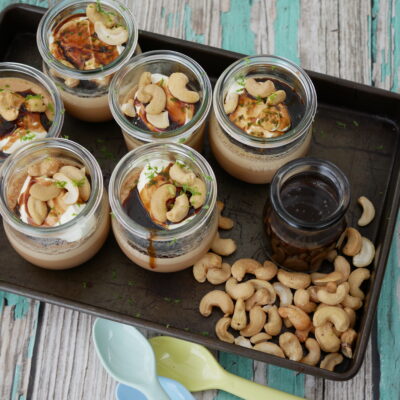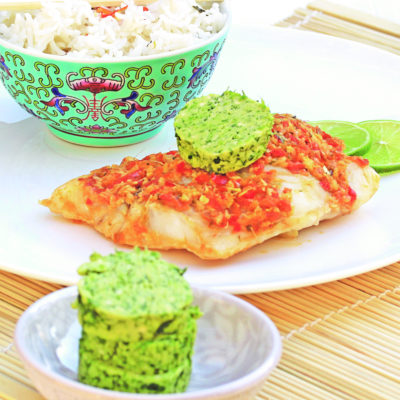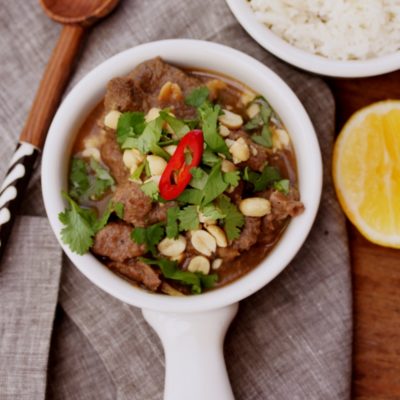Your Essential Thai Pantry
Your Essential Thai Pantry
Thai food ain't about simplicity. It's about the juggling of disparate elements to create a harmonious finish. Like a complex musical chord it's got to have a smooth surface but it doesn't matter what's happening underneath. Simplicity isn't the dictum here, at all. Some westerners think it's a jumble of flavours, but to a Thai that's important, it's the complexity they delight in.
I love Thai food and flavours. In fact this year we were planning a foodie expedition to plan a foodie trip for 20201...it still could happen, COVID kind of put a crimp in my planning. I have chillies, lemongrass and Kaffir lime leaves growing in my garden, so I feel as though I can always pull a Thai dish together. Obviously, there are some basics you can have in your pantry that will get you channelling your inner Thai takeaway chef in moments...as well as a few good linked recipes on here of course!
Tamarind Paste
Tamarind paste is made from a sour, dark, sticky fruit that grows in a pod on a tamarind tree. While some cuisines use tamarind paste to make desserts and even candy, in Thai cooking it is used mostly in savory dishes. Classic pad Thai sauce is made with tamarind, as are some Thai curries and seafood dishes. Indian curries also call for tamarind. It is also a common ingredient in Indian and Mexican cuisines, as well as Vietnamese, Latin, and Caribbean cooking. It is also a key ingredient in Worcestershire sauce, contributing to the distinctive tang. These days you can buy it as a paste or block. The block is usually available in Asian suppliers but is far more tricky to use, so go with the paste which will keep unopened in the pantry for years or opened in the fridge for months (and months).
Dried Shrimp or Belacan
Shrimp paste, made with fermented shrimps and salt, is the foundation of many Southeast Asian dishes especially in Thai, Indonesian and Malaysian cuisines. Called belacan in Malaysia, it is also known as terasi in Indonesia, mam ruoc or mam tom in Vietnam, kapi in Laos and bagoong in the Philippines. Shrimp paste may be wet or dry and the color varies from pale pink to deep reddish-brown. Adding a small amount of shrimp paste to a dish gives it a rich umami flavor. I often just use dried shrimp as they don't smell too bad, but a jar of shrimp paste in the fridge is quite handy.
Belacan is a shrimp paste in dry form made and before it is added to a dish, belacan must be roasted to release its flavors and aroma. I suggest you do not do this inside the house as you will drive the family into an early grave. Alternatively, doing it outside will alienate your neighborhood. However, to use it effectively it must be roasted. Wrap a piece in foil and put it onto your BBQ then run a long way away. It is very umami. VERY.
Roasted peanuts
Thai food is full of roasted crushed peanuts in desserts and mains. They add texture, crunch, and that little salty element. I always re-roast my peanuts, even though I buy roasted ones. I don't like an under roasted peanut. Just saying. So put them on a tray into a cold oven set to 200°C and roast for 10 minutes. You will thank me!
Palm or coconut sugar
Palm sugar and coconut sugar are two different types of sugars used in southeast Asia. Both are natural sweeteners that come from trees. Coconut sugar comes from the buds of coconut tree flowers and is dehydrated. Palm sugar is made from the sap of the sugar palm tree (also called a date palm tree). Like the process to make maple syrup, the sap is boiled in enormous vats to create either a sugar paste (sold in jars or tins) or rock-like chunks of sugar also known as "jaggery". It is caramel in flavour and sometimes a little smoky which adds a certain charm to your dishes. Coconut sugar comes in a granular form and is quite easy to sub into any recipe in the same quantities. I often used to write coconut palm sugar, you can use either/or where it is written coconut palm, palm, or coconut sugar! (So many options!)
Coriander or Cilantro
In fact coriander refers to the seeds or ground spice and cilantro to the green leaves of the same plant. But in Australia we call the green leaves coriander leaves usually. I love this herb. It is polarising. Loads of people hate it. There seems to be no middle ground. So...add liberally after a dish is cooked as it will add a fresh definitive Thai flavour. Or avoid completely. You could replace cilantro with Thai basil leaves if you are one of the haters.
Rice Noodles
I love fresh rice noodles. You can make them of course, but to buy them is cheap and easy and they keep well in the fridge. Just head to your local Asian supermarket for them, and keep them in your fridge until you are ready to go. They take minutes to warm up in hot water. No cooking required. If you haven't ever made them, they are kind of fun to make and the kids will enjoy it. I have a video to help you through!
Kaffir Lime Leaves
Kaffir or more accurately 'makrut' lime leaves are a key ingredient in Thai cooking as well as other Southeast Asian cuisines. They are probably one of the most aromatic of all herbs and a wonderful addition to many Thai and Southeast Asian soups, curries, and stir-fries. The thick leaves are dark green and shiny on one side, and pale-colored and porous on the other. They are sold fresh, frozen, and dried. I have them growing and they are amazing. I shred them as a garnish quite often and add them to a dish. They are sinuous, so fine shredding is essential.
Coconut Cream or Milk
I have a very good recipe for coconut cream or milk (and then the leftovers are coconut flour) but you must use shredded dried coconut as opposed to desiccated coconut. However, to have a few tins of coconut cream and milk or a UHT carton is such a simple and cheap thing, do it! Thai curries are usually cooked in coconut cream because after all, the country produces A LOAD of the global coconut cream/milk quota, (behind Dominican Republic and Indonesia)! I love the Kara brand UHT brand for desserts, and whipping in the place of dairy cream. (See LIVE video) For other applications I make my own or use Ayam or Honest to Goodness brands which have no nasties and work well with everything.
Birdseye chillies or chillies in general
The smaller the chilli, normally, the hotter. Thai cuisine often uses birdseye chillies which are little red chillies and they are hot. For my recipes I have defaulted to just saying, use 1 red chilli, 1 green chilli etc. To reduce heat, de-seed the chillies carefully, use gloves if you are sensitive in anyway. Dried chillies are easy to store and can reconstitute easily in boiling water for a few minutes. I grow chillies, but you probably figured that out already!
Lemongrass
No Thai pantry would be complete without lemongrass. Should you have a plant you will know it goes like mad and needs constant reducing. So ask a friend for a piece of theirs. It just keeps doubling. It is very hard to kill. (YAY)
Lemongrass is a herb or grass with a lemony scent. The culinary herb is produced from the stalk of the lemongrass plant. This plant grows in many tropical climates, most notably in Southeast Asia. It is a common ingredient in Thai cooking and can also be found in dishes from Indonesia, Sri Lanka, and India. Generally you use the white part of the stalk or root, smash it a little to release the aroma and then remove it before eating. It is stringy and hard to break down, but sooo yummy! It is also used in teas, and the green leafy part can be used as a tea.
For so many Thai recipes and the Thai Ebook
So there you have it. Time to Thai harder and get your pantry Thai-ed up! Delicious recipes abound if you pantry is ready with the right ingredients. Perhaps I should start a herb garden article! There are a few standards that you can easily grow and have instant flavour! Happy Thai-ing!
More from Thermomix and Cooking Tips

Tenina Holder
Tenina Holder is a wife, mother of five and grandmother of eight, who started cooking in the olden days before Thermomix was even a thing.
Tenina has become the premium go to source for all Thermomix expertise and of course fresh and easy recipes that work. Her cooking classes and foodie trips are sold out in literally hours, her cookbooks appear on the Australian best seller lists and her social reach is in the millions. Her Insider Club is the most fun you can have with a Thermomix and you really should join her! She believes chocolate, butter and salt are health foods. Her food positivity mantra is, eat everything, just not all at once!


























